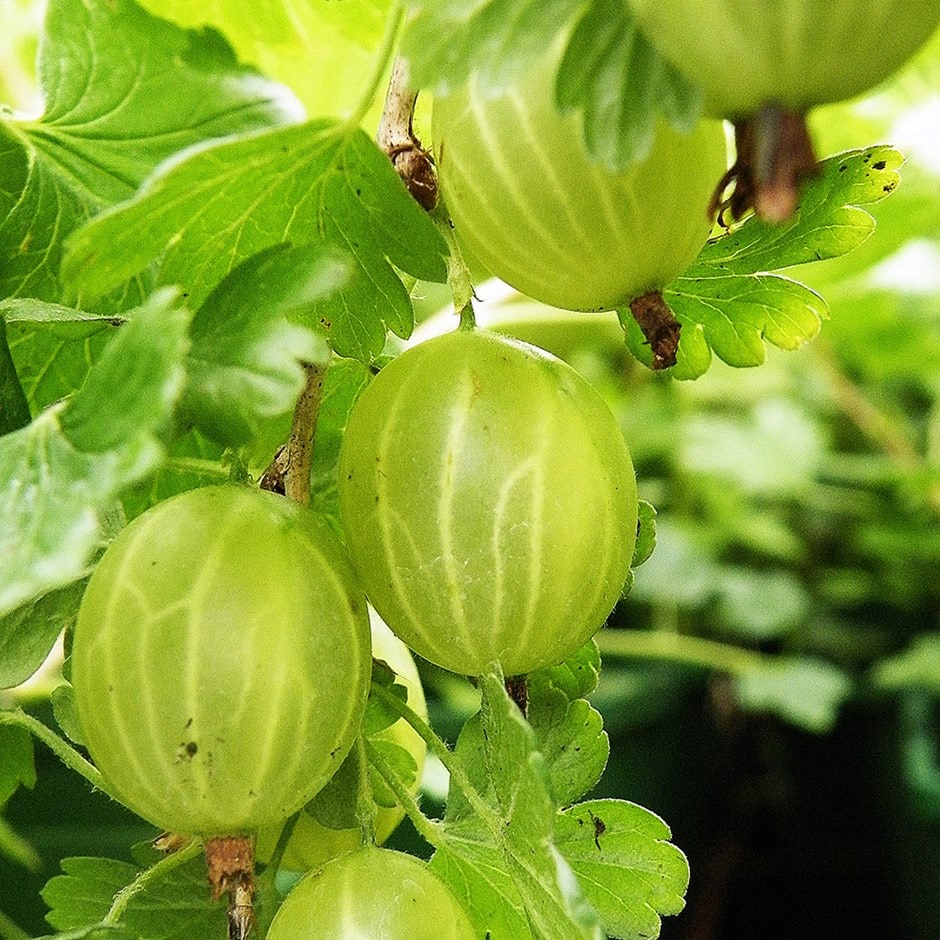
Position: full sun, but some shading needed in very hot weatherSoil: any well-drained soilRate of growth: averageHardiness: fully hardy
Reliably producing a bumper crop of larger than average green fruits, which have a sweet and aromatic flavour, this gooseberry is also hailed as being resistant to powdery mildew. Once harvested, the mid-season crop can be eaten straight from the bush, or used to make an array of puddings and jellies.
Garden care: Prepare the ground well before planting. Remove all weeds and dig in plenty of well-rotted manure into the area. Space at 1.5m intervals and once planted, apply a mulch of well-rotted manure every spring, as well as a nitrogen and potassium fertiliser. Make sure the plant is watered in dry weather and net the bushes to protect the fruit from birds.
Gooseberries are often grown as open-centred bushes with a good branching structure on a short stem and fruit on one year old wood. Prune in late winter/early spring. In the first year, prune all the shoots by 50-75% in winter. Tip prune any previously pruned shrubs to encourage the formation of side shoots. In their second winter, choose 8 to 10 of these new stems to form the main framework and shorten them by up to 25%. Remove any remaining shoots that are growing into the centre of the bush or are crossing/rubbing against other branches. Finally cut back all the remaining shoots to within four buds from the main stems.
In subsequent years, the plant can be pruned in two ways. Establishing fruiting spurs will produce a small crop of larger fruits, while removing whole branches right back to their base will produce a bigger crop of smaller fruit. To form fruiting spurs, cut back all the shoots that have formed in the previous year to a bud approximately 8cm from the point where it joins the main stem. New branch leaders should also be cut back to within a few buds of the older wood. Alternatively, completely remove old, weak or crossing branches to open up the centre of the bush and then cut back any growth that is coming from below 10cm above ground level.
Reliably producing a bumper crop of larger than average green fruits, which have a sweet and aromatic flavour, this gooseberry is also hailed as being resistant to powdery mildew. Once harvested, the mid-season crop can be eaten straight from the bush, or used to make an array of puddings and jellies.
Garden care: Prepare the ground well before planting. Remove all weeds and dig in plenty of well-rotted manure into the area. Space at 1.5m intervals and once planted, apply a mulch of well-rotted manure every spring, as well as a nitrogen and potassium fertiliser. Make sure the plant is watered in dry weather and net the bushes to protect the fruit from birds.
Gooseberries are often grown as open-centred bushes with a good branching structure on a short stem and fruit on one year old wood. Prune in late winter/early spring. In the first year, prune all the shoots by 50-75% in winter. Tip prune any previously pruned shrubs to encourage the formation of side shoots. In their second winter, choose 8 to 10 of these new stems to form the main framework and shorten them by up to 25%. Remove any remaining shoots that are growing into the centre of the bush or are crossing/rubbing against other branches. Finally cut back all the remaining shoots to within four buds from the main stems.
In subsequent years, the plant can be pruned in two ways. Establishing fruiting spurs will produce a small crop of larger fruits, while removing whole branches right back to their base will produce a bigger crop of smaller fruit. To form fruiting spurs, cut back all the shoots that have formed in the previous year to a bud approximately 8cm from the point where it joins the main stem. New branch leaders should also be cut back to within a few buds of the older wood. Alternatively, completely remove old, weak or crossing branches to open up the centre of the bush and then cut back any growth that is coming from below 10cm above ground level.
How to care for gooseberry Hinnonmäki Grön:
Prepare the ground well before planting. Remove all weeds and dig in plenty of well-rotted manure into the area. Space at 1.5m intervals and once planted, apply a mulch of well-rotted manure every spring, as well as a nitrogen and potassium fertiliser. Make sure the plant is watered in dry weather and net the bushes to protect the fruit from birds.
Gooseberries are often grown as open-centred bushes with a good branching structure on a short stem and fruit on one year old wood. Prune in late winter/early spring. In the first year, prune all the shoots by 50-75% in winter. Tip prune any previously pruned shrubs to encourage the formation of side shoots. In their second winter, choose 8 to 10 of these new stems to form the main framework and shorten them by up to 25%. Remove any remaining shoots that are growing into the centre of the bush or are crossing/rubbing against other branches. Finally cut back all the remaining shoots to within four buds from the main stems.
In subsequent years, the plant can be pruned in two ways. Establishing fruiting spurs will produce a small crop of larger fruits, while removing whole branches right back to their base will produce a bigger crop of smaller fruit. To form fruiting spurs, cut back all the shoots that have formed in the previous year to a bud approximately 8cm from the point where it joins the main stem. New branch leaders should also be cut back to within a few buds of the older wood. Alternatively, completely remove old, weak or crossing branches to open up the centre of the bush and then cut back any growth that is coming from below 10cm above ground level.
Gooseberries are often grown as open-centred bushes with a good branching structure on a short stem and fruit on one year old wood. Prune in late winter/early spring. In the first year, prune all the shoots by 50-75% in winter. Tip prune any previously pruned shrubs to encourage the formation of side shoots. In their second winter, choose 8 to 10 of these new stems to form the main framework and shorten them by up to 25%. Remove any remaining shoots that are growing into the centre of the bush or are crossing/rubbing against other branches. Finally cut back all the remaining shoots to within four buds from the main stems.
In subsequent years, the plant can be pruned in two ways. Establishing fruiting spurs will produce a small crop of larger fruits, while removing whole branches right back to their base will produce a bigger crop of smaller fruit. To form fruiting spurs, cut back all the shoots that have formed in the previous year to a bud approximately 8cm from the point where it joins the main stem. New branch leaders should also be cut back to within a few buds of the older wood. Alternatively, completely remove old, weak or crossing branches to open up the centre of the bush and then cut back any growth that is coming from below 10cm above ground level.
Eventual height:
1.2m
Eventual spread:
1.2m
Position:
Full sun / light shade
Rate of growth:
Average
Soil:
Moderately fertile, moist, well-drained soil
Hardiness:
Fully hardy
-
This plant is deciduous so it will lose all its leaves in autumn, then fresh new foliage appears again each spring.
Product options

3 litre pot
£21.99
In stock
(shipped within 2-3 working days)
(shipped within 2-3 working days)

2 + 1 FREE 3 litre pots
£43.98
£14.66 each
In stock
(shipped within 2-3 working days)
(shipped within 2-3 working days)

bare root plant
£12.99
available to order from autumn
Unavailable

2 + 1 FREE bare root plants
£25.98
£8.66 each
available to order from autumn
Unavailable
1
Delivery options (pick your preferred option at checkout)
Standard Delivery£5.99
Named Day Delivery£10.99








